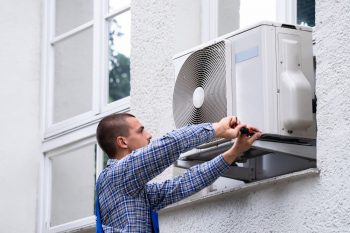
Installing a ceiling fan is a practical home improvement project that can help reduce energy costs and improve comfort in your home. However, the process can seem daunting if you haven’t done it before. In this comprehensive guide, we’ll walk you through every step of how to hook up a ceiling fan, from the tools you need to safety precautions, installation, and troubleshooting.
Hooking up a ceiling fan involves several steps: start by gathering all necessary tools and materials, then turn off the power and prepare the ceiling. Install the fan mounting bracket and wire the fan according to the manufacturer’s instructions. Attach the fan blades and light fixture, if included. Finally, check the fan balance to ensure it operates smoothly and efficiently. If you’re unsure about any part of the installation process, consider hiring a professional electrician.
Tools and Materials Needed
Before getting started, gather all the necessary tools and materials. This includes:
- Ladder
- Wire cutters/strippers
- Circuit tester/voltage detector
- Adjustable wrench
- Pliers
- Screwdrivers
- Eye protection
- Work gloves
- Ceiling fan
- Ceiling fan electrical box (if needed)
- Ceiling fan mounting kit
- Downrod extender (if necessary)
- Electrical tape
- Light kit (if using)
- Wire nuts
Remember to always use tools in good working condition to ensure a safe and secure installation.
Preparing the Ceiling
Before you start installing the fan, there are some preliminary steps that you need to take:
- Turn off the power: Safety first! Turn off the power at the main breaker panel and leave a note to prevent anyone from accidentally restoring power during the installation.
- Check the junction box: Make sure the existing electrical or junction box is rated for ceiling fan use. If it’s not, replace it with one that is.
- Install a fan brace if necessary: If the existing junction box is not fan-rated, you may need to install a fan brace to provide additional support.
- Measure the ceiling height and angle: Always check the ceiling height and angle before installing a downrod. Ceilings with steep angles or a sloped ceiling may need a special downrod or mounting bracket.
- Ensure proper clearance: For optimal performance, the fan should have enough clearance from the ceiling, floor, and walls.
Installing the Fan Mounting Bracket
Once the ceiling is prepared, the next step is to install the fan mounting bracket. This bracket will support the weight of the fan, so it’s crucial to install it correctly.
- Secure the mounting bracket to the junction box or support brace, following the manufacturer’s instructions.
- If the fan has a slide-on bracket, you can leave the mounting bolts on the junction box and simply slide the fan bracket over the mounting screws. Tighten them securely.
Wiring the Fan
The next step is to wire the fan. This is a critical step, and it’s essential to do it correctly to prevent electrical problems or safety hazards. Here’s how to do it:
- Identify the wires from the household circuit and the fan. Typically, the black wire is for the fan, the blue wire is for the light (if included), the white wire is neutral, and the green or copper wire is for grounding.
- Connect the corresponding wires from the fan to the household circuit using wire nuts. Secure the connections with electrical tape.
Attaching the Fan Blades and Light Fixture
After wiring the fan, the next step is to attach the fan blades to the motor housing. Once the blades are attached, you can also install the light fixture if your ceiling fan includes one.
- Secure each blade to the blade iron (the bracket that holds the blade to the fan) with the screws provided.
- If the fan has a light, connect the blue wire from the fan to the blue or black wire from the household circuit (depending on whether there are one or two switches on the wall).
Checking the Fan Balance
Finally, once the fan is fully installed, it’s important to check that it’s balanced. An unbalanced fan can wobble, make noise, and wear out the motor prematurely.
- Clean the fan and blades thoroughly.
- Check blade height: Measure the distance between each blade and the ceiling to ensure they are all at the same level.
- Use a balancing kit: If the fan still wobbles after following the previous steps, use a ceiling fan balancing kit to balance the blades.
By following this comprehensive guide, you should be able to hook up a ceiling fan safely and efficiently. However, if you’re unsure about any part of the installation process, consider hiring a professional electrician to ensure a safe and proper installation.
Frequently Asked Questions
Can I install a ceiling fan where a light fixture used to be?
Yes, you can install a ceiling fan where a light fixture used to be. However, you should ensure that the existing electrical box is rated for ceiling fan use. If it’s not, it needs to be replaced with one that is.
What size of ceiling fan should I choose for my room?
The size of the ceiling fan you should choose depends on the size of your room. As a general rule, for a room up to 75 square feet, choose a fan with a diameter of 29 to 36 inches. For a room between 76 and 144 square feet, choose a fan with a diameter of 36 to 42 inches. For rooms between 144 and 225 square feet, choose a fan with a diameter of 44 inches. For rooms that are 225 square feet or larger, choose a fan with a diameter of 50 to 54 inches.
How high should I hang my ceiling fan?
The ideal height for a ceiling fan is 8 to 9 feet from the floor. If your ceiling is higher, you may need to use a downrod to lower the fan to the optimal height. The minimum clearance between the floor and the fan blades should be 7 feet.
Can I use a dimmer switch with my ceiling fan?
Dimmer switches should not be used with most ceiling fans. Using a dimmer switch can damage the fan motor, and it could also cause the fan to buzz. Instead, use a fan speed control that is specifically designed for use with ceiling fans. If your fan includes a light, you can use a separate dimmer switch to control the light.
What does it mean to balance a ceiling fan?
Balancing a ceiling fan means ensuring that the fan blades are all at the same level when the fan is in use. An unbalanced fan can wobble, make noise, and cause the motor to wear out prematurely. You can use a ceiling fan balancing kit to balance the blades.












